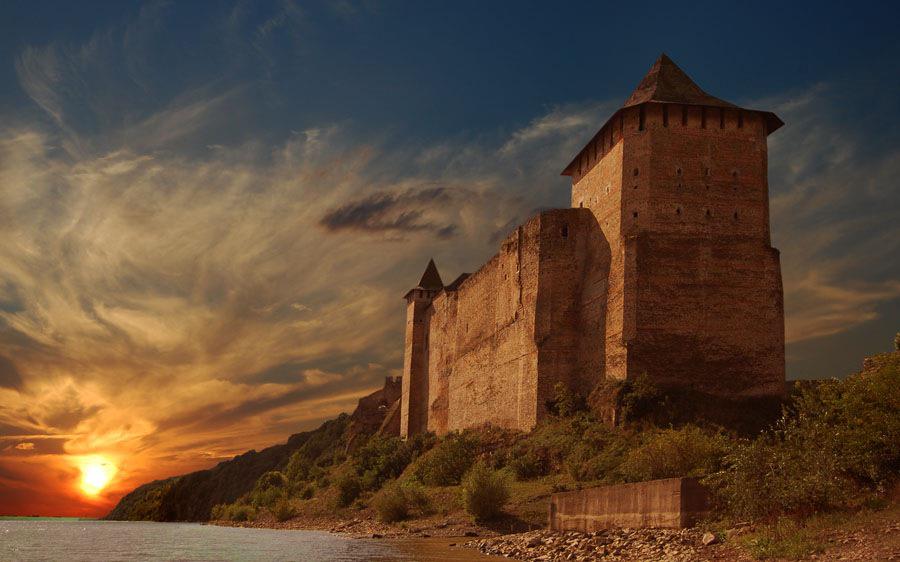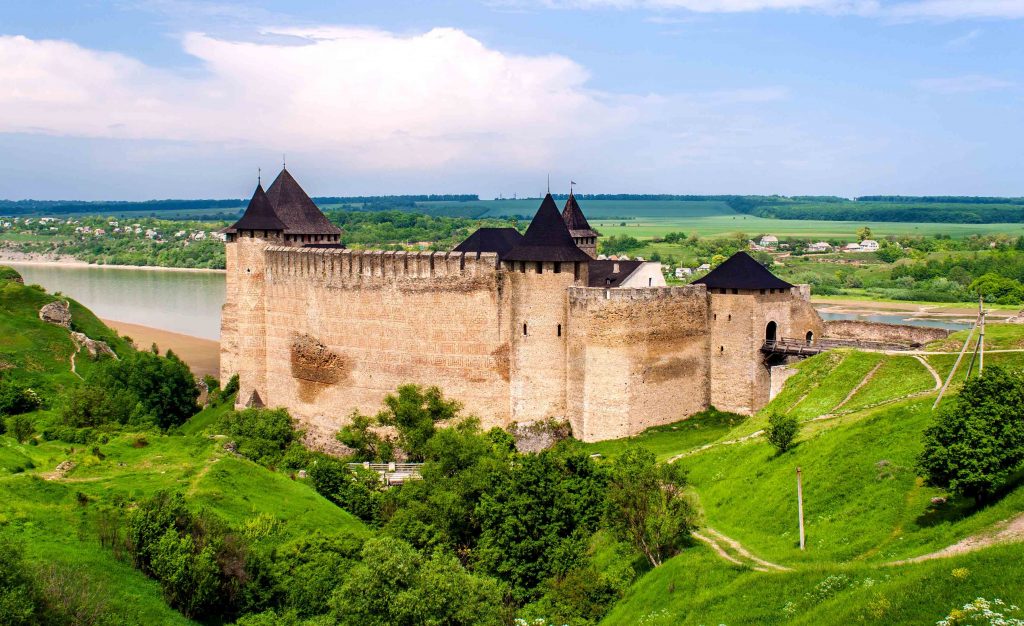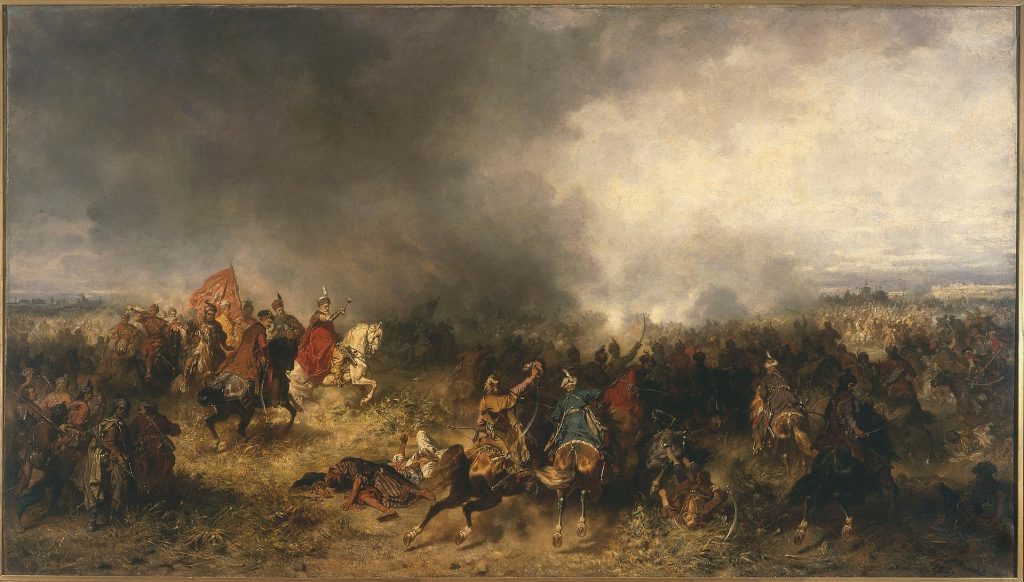From a distance, it is small and insignificant. Up close, it is enormous and impressive. Its thick walls reached 6 meters in the 15th century! Its height is 40 meters. Then, in the 15th century, it looked like a 14-storey building! And what are worth those patterns on walls?! And thank God, we can not only write about it but also see first-hand and feel all the greatness of Khotyn fortress, which is one of the seven wonders of Ukraine. Unlike other castles and fortresses in Ukraine, which live out their history and slowly dissolve in time, Khotyn enjoys its glory. They take care of it, guard it and even open new exhibitions. Every day tourists visit the fortress, view it from all sides, and from different angles, it looks in a new way.
Pay attention to Winter Tours in Ukraine.
Where is Khotyn Fortress located?
The fortress is in one of the oldest towns in Ukraine; it has already celebrated its Millennium anniversary. Few people know that Khotyn, which is now a district centre, used to lie at the intersection of trade routes, and later – on the borders of different states. Therefore, merchants from different countries of Western and Eastern Europe used to come to Khotyn’s fairs. And Khotyn itself was a tempting morsel, that’s why different peoples fought for it. Having a strategic location, Khotyn was desirable for many countries for centuries, so it survived battles, war and siege. Turks, Poles and Russians wanted to own the town, so its history was both dramatic and heroic.

Brief history of Khotyn
In X-XI centuries Khotyn was part of Kyivan Rus. Later, since 1199, it belonged to Halych-Volyn Principality. In 1373, Khotyn became a Moldovan town and was the residence of the Moldovan owners. In the XVI century, Poland ruled the town, and in the XVIII century, it belonged to the Ottoman Empire. After the Russian-Turkish War of 1806-1812, Khotyn came under the reign of the Russian Empire. From 1918 to the beginning of World War II the town was under the Romanians.

History of Khotyn Fortress
Khotyn fortress is one of the brightest historical and architectural monuments in Ukraine. At first, Prince Volodymyr Sviatoslavovych built a fort at this place in the 10th century and later a stone castle arose at the site due to King Danylo Halytskyi and his son Lev. Over the centuries, the stronghold changed its appearance. They made improvements, rebuilt and extended it a lot of times.

The fortress acquired its contemporary look in the 15th century. They expanded the area of the fortress and raised the level of the courtyard. The reconstruction took place during the reign of Stefan the Great. The Moldavian ruler built a 40-meter high and 6-meter thick wall to keep the fortress from cannon fire. At the same time, some unusual symbols appeared which are visible even now. These are Christian symbols of two kinds – the so-called Babylons (symbols of the architect’s wisdom) and Calvaries (symbols of the Holy Mountain). Legends credit them with a powerful force that helped the fortress to withstand.
The castle had running water which ran through ceramic pipes from the well to the living quarters of the castle. There was a sewer, too.
The well also deserves attention, especially its depth, because it was not some 10 meters, but as much as 62 meters since the fortress was on a rock, and it was not easy to reach the water.
In the XVIII century, when the citadel belonged to the Turks, they built a new fortress with a minaret. However, tourists are more interested in another thing: harem. They say they had it there with over 30 girls.
In the XIX century, when the Russian Empire controlled the fortress, they built the Church of St. Olexandr Nevskyi for religious needs.

A period of decline began for the Fortress after it had lost its status of a military facility in the XIX century. The battles of the two World Wars made the destruction even worse. In 1941, the Red Army blew the minaret up.

The restoration of Khotyn fortress began in the 1960s after it got the status of a historical monument of the national importance.
A Strange Stain
Now Khotyn fortress is in pretty good condition. The only thing that worries and catches the eye is a stain on one of its walls. But experts reassure it has long been there. They say it emerged in the XVIII century. People have created a lot of legends to explain its origin. They connect it with the tears of a dead girl or tell about the man immured alive in the wall during the construction. They explain that it emerged because of the well in the castle courtyard. However, there is another explanation confirmed by examination – the damp stain was formed by drying oil.

Why Khotyn?
There are several versions as for the origin of the town name. For example, one of them claims that there was a man called Kho who built a fence (“tyn”), and the neighbours started to call the area Khotyn.
The other one connects the origin of the town name with the legendary Dacian leader Kotyson. But the most popular version among both residents and tourists is the following: the town name originated from the verb “khotity” (“khotyn”), meaning “want” in Ukrainian.
The place has its magic and fascinates with its beauty. It is not surprising that here there were ancient settlements where different peoples wanted to live, and princes and empires fought for the fortress.
Battles
Khotyn fortress has seen many wars, battles and sieges. Only during the XVI-XVII centuries, there were four battles near the stronghold, the largest of which took place in 1621.

Historians believe that it had played a key role in world history and forced the Ottoman Empire to reconsider its conquest plans. Although the Turks had a bigger army and even used fighting elephants in the battle, they could not resist the soldiers of the Polish-Lithuanian Commonwealth and Ukrainian Cossacks and agreed to peace. After the Cossacks led by Petro Sahaidachnyi showed how to fight, the Turks abandoned their plans to conquer Europe.
In 1991, 370 years after the battle, they erected a monument to the Ukrainian Hetman Petro Sahaidachnyi in Khotyn.

The fortress was restored and brought to a good state before the Khotyn’s millennium anniversary, and now it is in the list of “Seven Wonders of Ukraine”.
Khotyn fortress is not only about battles and sieges. It is about paintings, poems, films and folk songs,
”Oh Khotyn, an ancient castle, glorious around the world!”
You can see the walls of the fortress in many films such as “Zakhar Berkut”, “The Ballad of the Valiant Knight Ivanhoe”, “D’Artagnan and Three Musketeers”.
It is better to see the massive fortress walls in person than in the picture. Although they seem small from a distance, when you go down, you can appreciate how huge they are!

The fortress area is enormous. There are places to walk and places to see. In addition to the walls themselves, you should see its exhibits. Here you can see the equipment which they used while storming the fortress as well as the instruments of torture and execution. For numismatists, there is a unique collection of coins found in the fortress area.

You can visit Khotyn fortress any day. It works seven days a week. However, there is no railway in Khotyn. It is inconvenient to travel there without a car. But if you travel by a comfortable bus from Visit Ukraine agency, why not? What tour to choose: a two-day Kamianets-Podilskyi cruise, Kamianets-Podilskyi, Khotyn and Chernivtsi or a three-day tour Kamianets-Podilskyi, Chernivtsi + Bakota? It’s up to you!
Khotyn is a good idea for a day trip when you are visiting Western Ukraine. If you plan to stay in Ukraine for a long time, it is definitely a must-see.





